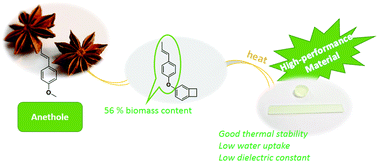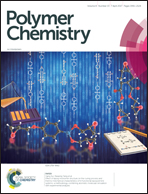Facile conversion of plant oil (anethole) to a high-performance material†
Abstract
Anethole, a naturally occurring aromatic compound which can be extracted abundantly from plants like star anise, fennel and basil, has been conveniently transformed to a functional monomer in an overall yield of 81% via a two-step procedure. The obtained monomer combines reactive benzocyclobutene and propylene groups, thus it can undergo thermo-polymerization to form a crosslinking network, showing a low dielectric constant (<2.64 in a range of frequencies varying from 0.1 to 30 MHz) and low water uptake (<0.20% in boiling water for 144 h). TGA and DSC data exhibit that the cross-linked network has a 5 wt% loss temperature of 455 °C in N2 and a Tg of 160 °C, respectively. These results indicate that the new polymer based on biorenewable anethole is comparable to the materials derived from petroleum. On the basis of the wide application of low dielectric constant materials in the microelectronic industry, this work would offer a new sustainable feedstock to organic low k materials. Moreover, this contribution also provides a new route to convert other aromatic natural products.



 Please wait while we load your content...
Please wait while we load your content...